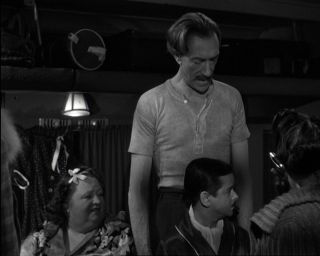The MacGuffin: News and Comment (17/May/2008)
(c) Ken Mogg (2008)
May 17
Still working on my 'files' (such as they are) this week, I came across an article from the 'New York Times', dated 5 September 1937. It's called "Hitchcock: Master Melodramatist" by B.R. Crisler, and was written after Crisler met Hitchcock. 'Mr Hitchcock is on his way to Hollywood (his first visit) for a two-week vacation', he notes; 'when we talked to him last week he denied that there is any likelihood of his immediate annexation by America, despite encouraging rumors.' A couple of things about the article stood out for me. First, Crisler says this: 'But the whole point of the matter - divorced from all the fine talk of camera angles, the accumulation of suspense, the trick of informing the commonplace with mysterious and terrible significance - [is that Hitchcock] is the only director alive, or active today, who does all his directorial thinking in camera terms.' Hmm. Did Hitchcock, already his own best propagandist, tell Crisler that? His point, years later, to Truffaut, that too many directors make 'pictures of people talking', is already being made by Crisler, who refers to pictures that 'talk themselves to death'. It's a point that may even be broadly true (though with apologies to, say, John Ford, Ernst Lubitsch, and Sergei Eisenstein), but at the same time I wouldn't want to downplay the Hitchcock 'trick of informing the commonplace with mysterious and terrible significance', which Crisler almost does here. Which brings me to what Crisler calls a 'purely playful idea' of Hitchcock's that is quoted later in the article. Here it is, and I think it's fascinating in the context of Hitchcock's work to come. '[O]ne thing he longs for is the opportunity to do a conventional Keystone sequence of cops being consecutively bopped on the head as they emerge from a hole (he has a Freudian complex of cop-hatred). At about the seventh cop, he would have the camera move in, showing the blood streaming down the face of the victim, then the arrival of the ambulance, the victim borne away on a stretcher to the operating table, the family waiting tearfully outside. Then back to the hole again, bopp, bopp, bopp - one flatfoot after another. He thinks it would illuminate the proceedings no end.' More than a quaint or 'purely playful idea', this is a splendid, even brilliant, exemplar of how things are in the Hitchcock universe. (Note, by the way, that it simply won't do to speak of Hitchcock's 'Freudian complex of cop-hatred', even in the context of the anecdote itself. In that very year, Hitchcock had made Young and Innocent which simultaneously makes gentle fun of cops performing their prescribed duties and gives us a sympathetic portrait of a local Chief Constable who is clearly a humane man who is open to the possibility of innocence in a man accused. He anticipates, say, Chief Inspector Oxford in Frenzy [1972].) Much more than a satire on cops, the anecdote both critiques and educates the Hitchcock audience. It shows us to be very often conditioned by what the philosopher Schopenhauer called 'ordinary consciousness' and which he, Schopenhauer, contrasted to the truer consciousness of the artist, who can see the bigger picture. Actually, I thought of a line the screenplay of Saboteur (1942), five years later, would give to one of the circus 'freaks', the one known as 'the Human Skeleton' or 'Bones' (Pedro de Cordoba), who says that normal people are 'normally cold-hearted'. (That's the element of critique in the anecdote, note. See frame-capture below.) But I also thought of something that Hitchcock remarked about the people in his film The Birds (1963), that they may normally be complacent and 'unaware that catastrophe surrounds us all' (which is pure Schopenhauer) but that when crisis comes, 'people are all right' and can rise to the occasion, as, commented Hitchcock, the British did during World War Two. (Here, as in his anecdote, Hitchcock is educating and appealing to the good nature of his audience.) Of course, as Raymond Durgnat did in 'The Strange Case of Alfred Hitchcock' (1974), you may see this dual way of thinking by Hitchcock about his audience as all rather shallow, a mere eddying back and forth, before, with the voice of the moralist, insisting that people 'grow up, a little'. But the anecdote (rather like one by Schopenhauer about a boatman complacently rowing his boat on a wide sea with a storm approaching) is too vivid and too true, to be dismissed as simple-minded, which Dugnat would have us do. Hitchcock's admirable capacity for dual-mindedness and seeing the bigger picture informs a film like Stage Fright (1950), which I'll talk about next time.
This material is copyright of Ken Mogg and the Hitchcock Scholars/'MacGuffin' website (home page) and is archived with the permission of the copyright holder. |

